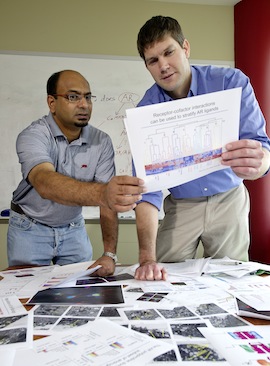Researchers at the University of Houston (UH) have been awarded more than $862,000
in federal grants to pursue projects related to prostate cancer, diabetes and obesity.
The U.S. Department of Defense (DOD) and National Institutes of Health (NIH) will
fund two new prostate cancer projects, while a third NIH grant will support diabetes
and obesity research in the UH Center for Nuclear Receptors and Cell Signaling (CNRCS).
The center’s research projects now account for eight active NIH grants, a key indicator
in Tier One rankings.
“Success in today’s competitive federal funding landscape is validation of the motivation
and ingenuity of our researchers,” said Dr. Jan-Åke Gustafsson, director of CNRCS.
“With these new awards we are now able to explore new avenues of investigation into
the treatment and prevention of these important diseases.” 
“Grants are critical to our research, not only for funding but also building and maintaining
a reputable track record on the national level,” said Frigo. “Our team is eager to
begin these new projects as we focus on identifying drug targets for possible clinical
trials in the next phases of research.”
Last month, Frigo additionally was awarded a $150,000 grant from the NIH’s National
Cancer Institute to expand his established research involving the treatment and prevention
of prostate cancer. The project, “Modulation of Branched-Chain Fatty Acids for the
Prevention of Prostate Cancer,” will examine how the convergence of specific biological
cues and our diets may function to promote cancer and could provide guidance for preventing
the disease. The project is Frigo’s third to be funded by the NIH, since joining the
center in 2010. 
In total, the CNRCS has 26 active grants. Overall, the center’s active projects account
for more than $18 million in research funding at UH, another significant metric for
Tier One status. Established in 2009, CNRCS is a focal point of the UH health initiative.
The center’s investigators are involved in many aspects of nuclear receptor research
and focused on understanding the roles of these receptors in health and disease. Cell
signaling is part of a complex system of communication where cells signal each other
to decide when to generate new cells. Errors in this processing are responsible for
the diseases they study.
###
About the University of Houston
The University of Houston is a Carnegie-designated Tier One public research university
recognized by The Princeton Review as one of the nation’s best colleges for undergraduate
education. UH serves the globally competitive Houston and Gulf Coast Region by providing
world-class faculty, experiential learning and strategic industry partnerships. Located
in the nation’s fourth-largest city, UH serves more than 39,500 students in the most
ethnically and culturally diverse region in the country. For more information about
UH, visit http://www.uh.edu/news-events/.
To receive UH science news via e-mail, sign up for UH-SciNews.
For additional news alerts about UH, follow us on Facebook and Twitter.